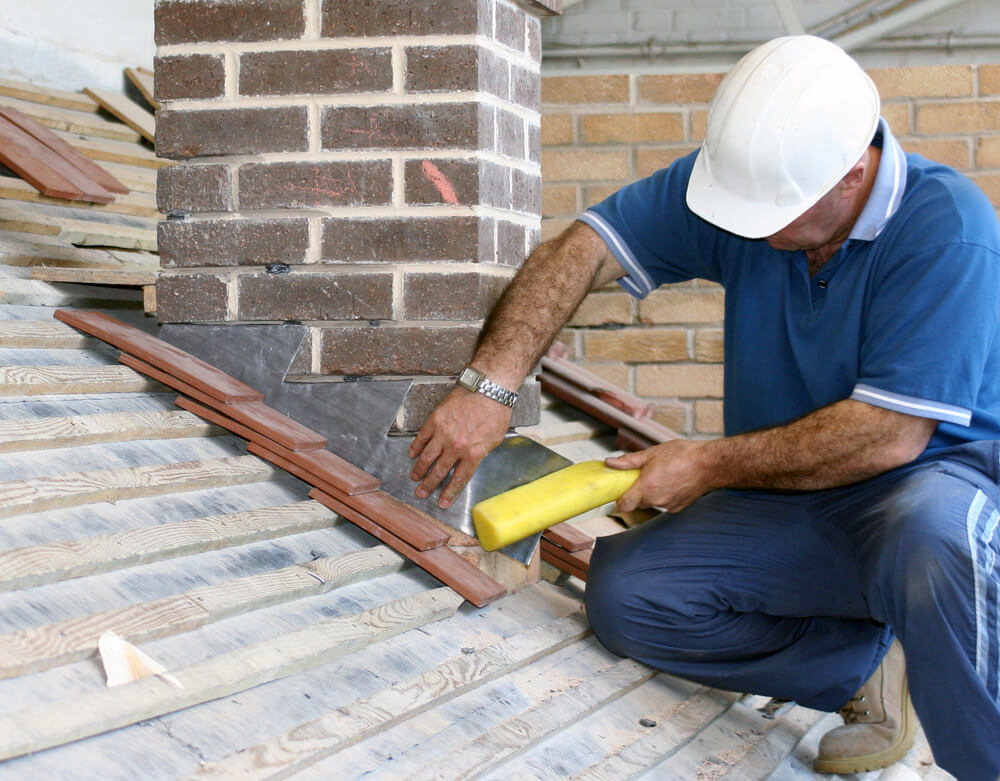Are you planning to replace your roof? If so, there may be several roofing contractors already who have furnished you with their roof replacement cost estimates. Unfortunately for you, understanding the various materials is crucial to know the cost of a roof repair & replacement investment. That’s why this post will assist you by demystifying one of the essential materials; roof flashing.
Roof flashing is a thin material that roofing contractors install to prevent water from entering your roof’s interior structure (chimneys, roof valleys, or walls). If these interior areas are not sealed correctly, such locations can be prone to leaks. These intersections contract and expand depending on humidity and temperature levels. Good roof flashing should help with this movement while also developing a tight seal that keeps moisture away from your roof and home.
What Is Roof Flashing?
Roof flashing is a thin material, customarily galvanized steel, that roofing contractors utilize to direct water away from critical areas of the roof, wherever the roof plane comes across a vertical surface such as a dormer or a wall. Simply put, it is also known as a weather-resistant barrier. It is typically installed to surround features of your roof, such as skylights, chimneys, and vents. Water should run down to the flashing side and be directed to the shingles instead of finding its way into the roof deck.
Generally, galvanized steel or aluminum is utilized to make roof flashing. The barrier is then put over wall construction and joints. You can easily find it in the pipes, valleys, around skylights, and around chimneys. It stops water from penetrating inside your roof, and in areas like a valley, it collects from two slopes and directs it down to the gutters. However, every area where it is placed works to direct water to your channels.
There are various roof flashing types. The most common types are apron flashing, counter flashing, and step flashing.
- Apron flashing: Also referred to as “continuous flashing” since it acts as an apron. It’s a single, long metal carried down to the roof below. Long pieces of apron flashing will have problems fixing as the home contracts and expands in the changing seasons. If left unattended, it could warp or break and fail to prevent water out. So, the long pieces come with built-in expansion joints so they can move with the home.
- Step roof flashing: Step flashing is primarily utilized against the sides of chimneys and walls. It works by putting a piece of metal under each shingle that is installed right against the side of a wall to prevent water from getting into it.
- Counter flashing: This type of flashing is utilized on chimneys and walls just like step flashing. Unlike step roof flashing, this kind of flashing is sawed into an existing joint, and metal will come on top of the brick.

Why Is Roof Flashing Necessary?
Now you understand what roof flashing is and the kind of material it is constructed from. However, here is the importance of roof flashing that you need to know:
Roof flashing prevents water damage
There are numerous hidden cracks in your roof that you might notice even with regular inspections. This is one of the significant reasons why roof flashing are usually installed. They stop moisture damage and act as a waterproof layer safeguarding your roof’s surface.
Saves on roof maintenance cost
Safeguarding your roof from weather hazards and water damage implies that you don’t have to repair or replace your roof frequently. Roof flashing are also inexpensive and easy to maintain. They can be reused as long as they are in perfect condition.
Increases your roof’s longevity
Regular roofs can last anywhere from one to five decades. However, it is pegged on factors like artistry quality, materials used and climate, etc. Putting roof flashing is one way to ensure you get the most out of your roofs. By covering and shielding cracks and edges, the longevity of your roofs will be increased significantly.
Different Types of Roof Flashing
Roof flashing needs to be weatherproof, rust-proof, accommodate weather changes, and have a low maintenance cost. Roof flashings are made from fabricated metals such as copper, aluminum, galvanized steel, and zinc which are tough, and rust proof. Here are some roof flashing materials you need to know:
1. Galvanized Steel
Coating steel metal sheets produce this flashing with a layer of zinc alloys. Utilize galvanized nails while fixing galvanized steel flashing as fasteners of various metal will soon rust.
2. Copper Roof Flashing
Copper is one of the most rust-proof and durable materials. It needs technique to design, install, fabricate, and cut. This roof flashing also requires an experienced and skilled roofing contractor for proper installation.
3. Stainless Steel Roof Flashing
Stainless steel is a durable metal roof flashing material customized for corrosive and harsh environments. It is advisable to fix them on counters and valleys.
4. Aluminum Roof Flashing
This flashing material is versatile and durable and can be installed around the vent, chimney, etc. It comes in different thicknesses. You can enhance the longevity of this roof flashing by anodizing or painting. Best of all, aluminum can be shaped according to your taste.
How Does Roof Flashing Keep Your Home Safe?
Roof flashing is essential in ensuring that water is directed away from critical areas of your roof. Flashing offers a way to waterproof your roof and keep your house safe from damage and leaks. It is utilized on various parts of your roof and can be installed in the valleys and slopes. Since roof flashing comprises, thin pieces installed beneath your roof, they can be fitted between the joints and hidden or exposed depending on where they are.
Need Help with Roof Flashing Installation? Contact us today
Are you planning for roof flashing repair or installation in Manchester TN, and need help figuring out where to start? Search no further! We are skilled in flashing and roofing installation and offer superior-grade, affordable services.
Reach out to us to schedule a free consultation and solve all your roofing problems today.

